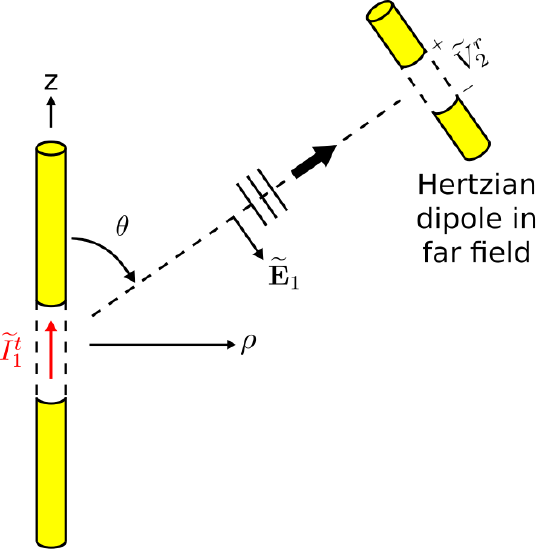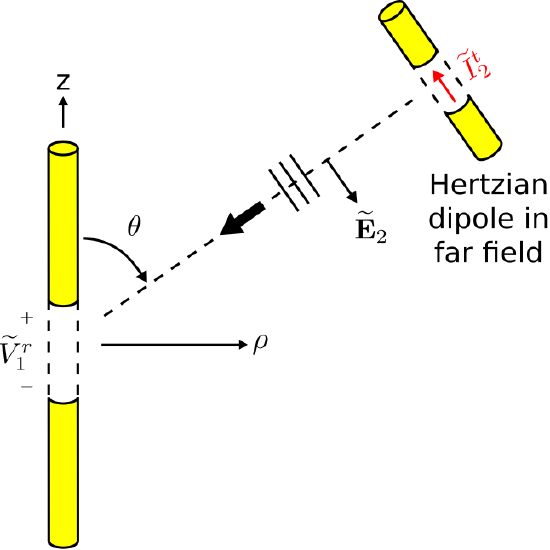10.11: Potential Induced in a Dipole
( \newcommand{\kernel}{\mathrm{null}\,}\)
An electromagnetic wave incident on an antenna will induce a potential at the terminals of the antenna. In this section, we shall derive this potential. To simplify the derivation, we shall consider the special case of a straight thin dipole of arbitrary length that is illuminated by a plane wave. However, certain aspects of the derivation will apply to antennas generally. In particular, the concepts of effective length (also known as effective height) and vector effective length emerge naturally from this derivation, so this section also serves as a stepping stone in the development of an equivalent circuit model for a receiving antenna. The derivation relies on the transmit properties of dipoles as well as the principle of reciprocity, so familiarity with those topics is recommended before reading this section.
The scenario of interest is shown in Figure 10.11.1. Here a thin ˆz-aligned straight dipole is located at the origin. The total length of the dipole is L. The arms of the dipole are perfectly-conducting. The terminals consist of a small gap of length Δl between the arms. The incident plane wave is described in terms of its electric field intensity ˜Ei. The question is: What is ˜VOC, the potential at the terminals when the terminals are open-circuited?
 Figure 10.11.1: A potential is induced at the terminals of a thin straight dipole in response to an incident plane wave. (CC BY-SA 4.0; C. Wang)
Figure 10.11.1: A potential is induced at the terminals of a thin straight dipole in response to an incident plane wave. (CC BY-SA 4.0; C. Wang)
There are multiple approaches to solve this problem. A direct attack is to invoke the principle that potential is equal to the integral of the electric field intensity over a path. In this case, the path begins at the “−” terminal and ends at the “+” terminal, crossing the gap that defines the antenna terminals. Thus:
˜VOC=−∫gap˜Egap⋅dl
where ˜Egap is the electric field in the gap. The problem with this approach is that the value of ˜Egap is not readily available. It is not simply ˜Ei, because the antenna structure (in particular, the electromagnetic boundary conditions) modify the electric field in the vicinity of the antenna.1
Fortunately, we can bypass this obstacle using the principle of reciprocity. In a reciprocity-based strategy, we establish a relationship between two scenarios that take place within the same electromagnetic system. The first scenario is shown in Figure 10.11.2.
 Figure 10.11.2: The dipole of interest driven by current ˜It1 radiates electric field ~E1, resulting in open-circuit potential ˜Vr2 at the terminals of a Hertzian dipole in the far field. (CC BY-SA 4.0; C. Wang)
Figure 10.11.2: The dipole of interest driven by current ˜It1 radiates electric field ~E1, resulting in open-circuit potential ˜Vr2 at the terminals of a Hertzian dipole in the far field. (CC BY-SA 4.0; C. Wang)
In this scenario, we have two dipoles. The first dipole is precisely the dipole of interest (Figure 10.11.1), except that a current ˜It1 is applied to the antenna terminals. This gives rise to a current distribution ˜I(z) (SI base units of A) along the dipole, and subsequently the dipole radiates the electric field (Section 9.6):
˜E1(r)≈ˆθjη2e−jβrr (sinθ) ⋅[1λ∫+L/2−L/2˜I(z′)e+jβz′cosθdz′]
The second antenna is a ˆθ-aligned Hertzian dipole in the far field, which receives ˜E1. (For a refresher on the properties of Hertzian dipoles, see Section 9.4. A key point is that Hertzian dipoles are vanishingly small.) Specifically, we measure (conceptually, at least) the open-circuit potential ˜Vr2 at the terminals of the Hertzian dipole. We select a Hertzian dipole for this purpose because – in contrast to essentially all other antennas – it is simple to determine the open circuit potential. As explained earlier:
˜Vr2=−∫gap˜Egap⋅dl
For the Hertzian dipole, ˜Egap is simply the incident electric field, since there is negligible structure (in particular, a negligible amount of material) present to modify the electric field. Thus, we have simply:
˜Vr2=−∫gap˜E1⋅dl
Since the Hertzian dipole is very short and very far away from the transmitting dipole, ˜E1 is essentially constant over the gap. Also recall that we required the Hertzian dipole to be aligned with ˜E1. Choosing to integrate in a straight line across the gap, Equation ??? reduces to:
˜Vr2=−˜E1(r2)⋅ˆθΔl
where Δl is the length of the gap and r2 is the location of the Hertzian dipole. Substituting the expression for ˜E1 from Equation 10.11.2, we obtain:
˜Vr2≈−jη2e−jβr2r2 (sinθ) ⋅[1λ∫+L/2−L/2˜I(z′)e+jβz′cosθdz′]Δl
where r2=|r2|.
 Figure 10.11.3: The Hertzian dipole driven by current Iet ˜It2 radiates electric field ˜E2, resulting in open-circuit potential ˜Vr1 at the terminals of the dipole of interest. (CC BY-SA 4.0; C. Wang)
Figure 10.11.3: The Hertzian dipole driven by current Iet ˜It2 radiates electric field ˜E2, resulting in open-circuit potential ˜Vr1 at the terminals of the dipole of interest. (CC BY-SA 4.0; C. Wang)
The second scenario is shown in Figure 10.11.3. This scenario is identical to the first scenario, with the exception that the Hertzian dipole transmits and the dipole of interest receives. The field radiated by the Hertzian dipole in response to applied current ˜It2, evaluated at the origin, is (Section 9.4):
˜E2(r=0)≈ˆθjη˜It2⋅βΔl4π (1) e−jβr2r2
The “sinθ” factor in the general expression is equal to 1 in this case, since, as shown in Figure 10.11.3, the origin is located broadside (i.e., at π/2 rad) relative to the axis of the Hertzian dipole. Also note that because the Hertzian dipole is presumed to be in the far field, E2 may be interpreted as a plane wave in the region of the receiving dipole of interest.
Now we ask: What is the induced potential ˜Vr1 in the dipole of interest? Once again, Equation ??? is not much help, because the electric field in the gap is not known. However, we do know that ˜Vr1 should be proportional to ˜E2(r=0), since this is presumed to be a linear system. Based on this much information alone, there must be some vector le=ˆlle for which
˜Vr1=˜E2(r=0)⋅le
This does not uniquely define either the unit vector ˆl nor the scalar part le, since a change in the definition of the former can be compensated by a change in the definition of the latter and vice-versa. So at this point we invoke the standard definition of le as the vector effective length, introduced in Section 10.9. Thus, ˆl is defined to be the direction in which an electric field transmitted from the antenna would be polarized. In the present example, ˆl=−ˆθ, where the minus sign reflects the fact that positive terminal potential results in terminal current which flows in the −ˆz direction. Thus, Equation ??? becomes:
˜Vr1=−˜E2(r=0)⋅ˆθle
We may go a bit further and substitute the expression for ˜E2(r=0) from Equation ???:
˜Vr1≈−jη ˜It2⋅βΔl4π e−jβr2r2le
Now we invoke reciprocity. As a two-port linear time-invariant system, it must be true that:
˜It1˜Vr1=˜It2˜Vr2
Thus:
˜Vr1=˜It2˜It1˜Vr2
Substituting the expression for ˜Vr2 from Equation 10.11.7:
˜Vr1≈−˜It2˜It1⋅jη2e−jβr2r2 (sinθ) ⋅[1λ∫+L/2−L/2˜I(z′)e+jβz′cosθdz′]Δl
Thus, reciprocity has provided a second expression for ˜Vr1. We may solve for le by setting this expression equal to the expression from Equation ???, yielding
le≈2πβ˜It1[1λ∫+L/2−L/2˜I(z′)e+jβz′cosθdz′]sinθ
Noting that β=2π/λ, this simplifies to:
le≈[1˜It1∫+L/2−L/2˜I(z′)e+jβz′cosθdz′]sinθ
Thus, you can calculate le using the following procedure:
- Apply a current ˜It1 to the dipole of interest.
- Determine the resulting current distribution ˜I(z) along the length of the dipole. (Note that precisely this is done for the electrically-short dipole in Section 9.5 and for the half-wave dipole in Section 9.7.)
- Integrate ˜I(z) over the length of the dipole as indicated in Equation ???. Then divide (“normalize”) by ˜It1 (which is simply ˜I(0)). Note that the result is independent of the excitation ˜It1, as expected since this is a linear system.
- Multiply by sinθ.
We have now determined that the open-circuit terminal potential ˜VOC in response to an incident electric field ˜Ei is
˜VOC=˜Ei⋅le
where le=ˆlle is the vector effective length defined previously.
This result is remarkable. In plain English, we have found that:
The potential induced in a dipole is the co-polarized component of the incident electric field times a normalized integral of the transmit current distribution over the length of the dipole, times sine of the angle between the dipole axis and the direction of incidence.
In other words, the reciprocity property of linear systems allows this property of a receiving antenna to be determined relatively easily if the transmit characteristics of the antenna are known.
A explained in Section 9.5, the current distribution on a thin ESD is
˜I(z)≈I0(1−2L|z|)
where L is the length of the dipole and I0 is the terminal current. Applying Equation ???, we find:
le≈[1I0∫+L/2−L/2I0(1−2L|z′|)e+jβz′cosθdz′]⋅sinθ
Recall β=2π/λ, so βz′=2π(z′/λ). Since this is an electrically-short dipole, z′≪λ over the entire integral, and subsequently we may assume e+jβz′cosθ≈1 over the entire integral. Thus:
le≈[∫+L/2−L/2(1−2L|z′|)dz′]sinθ
The integral is easily solved using standard methods, or simply recognize that the “area under the curve” in this case is simply one-half “base” (L) times “height” (1). Either way, we find
le≈L2sinθ
Example 10.9.1 (Section 10.9) demonstrates how Equation ??? with the vector effective length determined in the preceding example is used to obtain the induced potential.
- Also, if this were true, then the antenna itself would not matter; only the relative spacing and orientation of the antenna terminals would matter!↩


